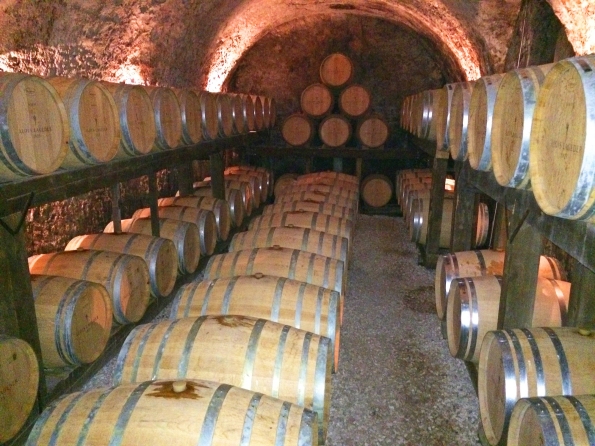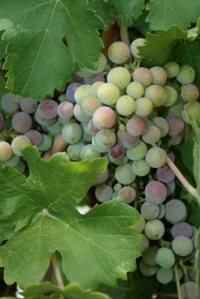Archive
Rising to the occasion: A yeast bug in your wine

With the right yeast, and enough of it to complete fermentation, someday there will be a finished wine in these barrels.
For most wine drinkers, the role of yeast in winemaking can be whittled down to the basics of fermentation: yeast eats the sugars in the grape juice and gives off ethanol alcohol, which is safe to consume in moderate amounts.
‘Nough said, open that bottle.
Last week, when discussing what are called “natural” wines, it was mentioned that some winemakers, in their desire not to add anything to the finished product, depend on naturally occurring yeasts on the grapes or in the winery to ferment their grapes.
Ripe grapes and other fruit have natural yeasts on their skin and as long as the skin isnt broken, fermentation doesn’t happen.
Crushing the grapes at the winery releases the juice, which the yeast eats and fermentation begins. Some anti-additive winemakers seek spontaneous fermentation by simply piling whole berries in the fermentation tank, where the weight of the upper layers squeeze the lower ones.

All ripe grapes have natural yeast on them; the only question is if it’s enough to complete fermentation.
They are betting there are enough yeasts either on the grapes or in the winery to take the juice all the way to the preferred level of dryness (a wine is completely dry when all the sugar has been converted to alcohol).
There are problems with that, said Stephen Menke, state enologist from Colorado State University and the Orchard Mesa Research Center, because not all yeasts are equal in their ability to start and complete a fermentation.
Menke said many native (or indigenous) yeasts are affected even by small amounts of the alcohol they produce and die before fermentation is finished.
If the yeasts die before all the sugar is consumed to the desired level of dryness, you get what’s called a “stuck” fermentation.
“What we call indigenous yeast bacteria are not very alcohol tolerant and may be involved in the earlier part of the fermentation process but not finish it,” Menke said.
As Menke noted, there are reasons other than alcohol levels for a stuck fermentation, including a lack of nitrogen or powdery mildew or even a killer yeast that takes over from the natural bugs but then topples.
If there is enough of the right yeast in the vats or winery to take over, you’re in luck. Many older wineries in Europe, where equipment has been used for generations, can be havens of yeast bugs, and have so much yeast on the walls and in the tanks there rarely are problems with stuck fermentations (that also contributes to a consistency in flavors but that’s for next time).
Not so in the high desert of western Colorado and elsewhere where generally low humidity and relatively new (and clean) equipment don’t foster microbial growth.
But when fermentations stick, winemakers have an ace in the hole.
That ace is our (mostly) alcohol-tolerant and fermentation resistant yeast, Saccharomyces cerevisiae.
Archeologists tell us winemakers in Armenia and China may have relied on naturally occurring Saccharomyces cerevisiae at least 6,000 years ago because it has the key attributes needed for fermentation–a tolerance to high sugar, elevated acidity and high alcohol levels.
Writer, wine blogger and scientist Erika Syzmanski, in a March 10, 2013 post on the online wine magazine Palate Press, said, “This is part of why ‘natural wine’ and ‘wild fermentation’ are slippery terms. inemaking practices have been influencing yeast survival for millennia. No yeast that finds its way into a winemaker’s vat, in this age, has been untouched by human domestication.”
Syzmanksi also points out Saccharomyces cerevisiae is the only yeast to be named a state microbe.
Winemakers today have hundreds of commercial Saccharomyces cerevisiae yeast options, most of them developed by a lab or a company to achieve specific results in the finished wine.
Finding the right yeast is a step toward finding that elusive balance in flavor and texture, Menke said.
“That dynamic balance is very hard to control, it’s always changing, “ he said. “That’s why people play around with blending different grapes or experiment in using different types of oak or how much oak, and the kind of yeast they use.”
When the topic of ‘natural’ turns to wine

Iconoclastic Slovenian winemaker Ales Kristancic of Movia is an innovative winemaker renowned for his visionary techniques, which include long aging, no additives and no manipulation.
I was breaking down some boxes for recycle when the lettering on one caught my eye.
“Natural wine,” it read. “No sulfites.”
An interesting claim, if true.
First because the federal government, which regulates winemaking and labeling, has no official definition of a “natural” wine, although many people would like to make and drink them; and second, because you can’t make a wine without sulfites.
You can make a wine without adding sulfites, which is what makers of “natural wines” and organic/biodynamic wines claim to do, but sulfites occur naturally in grapes, so at best what you can have is a low-sulfite wine.
I’m not a winemaker, nor am I a chemist or scientist, but I am a wine drinker and like most wine drinkers I have an interest in what I put in my glass and my body.
I’ve heard the claims about natural wines and also the complaints about so-called red wine headaches, which many people attribute to sulfites.
Probably not true, unless these people are among the 2 percent or less of Americans with a true allergy to sulfites, which occur not only in grapes (white wines often have more sulfites than red wines) but in many fruits and vegetables.
Do you also get an apricot headache?
More likely, according to recent research, a headache is a reaction to the histamines, also naturally occurring, in grapes.
Take an antihistamine before you drink a red wine and see if that helps your headache.
Sulfur/sulfites is a preservative, helping to keep fruit fresh and prevent oxidation.
Take a bit out of an apple, stick the apple on the counter and come back in an hour.
It’s brown, it’s oxidized. And probably doesn’t taste quite as good.
Sulfites, which are a natural byproduct of fermentation, help keep wines from oxidizing, retaining the fruit and helping the wine age (tannins and acids also aid in aging gracefully, at least for wines).
The government requires winemakers (and other food manufacturers and processors) to label their wines “sulfites added” when sulfites exceed 10 parts per million, which is about the upper level you’ll get without adding sulfites.
Small amounts of sulfites are generated by the yeasts used in making wine, but more sulfites usually are added as a preservative — more in white wine than red, because the reds’ tannins help to preserve them.
Sometimes a lot of sulfur is added – the government allows up to 350 ppm sulfites.
One of the complaints about “natural” wines, those with fewer than 10 ppm sulfites, is their short shelf life, which sulfites extend, and the rapid disappearance of the fruity flavors of the wine.
Natural wines tend to be drunk young, very young, within a day or so of opening and within a year or so of bottling.
The difference between organic wines and natural wines is what happens once the grapes reach the winery.
“Because you are an organic winemaker does not mean you are a ‘natural’ winemaker,” Paul Grieco said last month during his seminar on natural wines at the 2014 Food & Wine Classic in Aspen. “Being a natural winemaker means what happens when we get into the winery.
“You think wine is just grapes? Well, it ain’t just grapes.”
It may be chemicals, colorings, yeast, egg whites, diatomaceous earth, flavors, a witch’s brew of thing other than grapes.
Organic wines have to be made from organically (or biodynamically) raised and processed grapes.
Natural wines tend to be made from organic or bio grapes but not always, and again, it’s what happens in the winery (where the sulfite, the yeasts for fermentation and other chemicals may be added, at any of various stages of conventional winemaking) that decides if a wine is “natural” or not.
“Here is what I, and it’s just me talking, think a ‘natural’ wine should be,” said Grieco, owner of the Hearth Restaurant and Terroir chain of wine bars in New York and who last year was named the second-most influential wine person in New York City, behind Eric Asimov, wine columnist for the New York Times. “The fruit in the vineyard should be at least organic, the harvest must be manual to give you pristine fruit, only indigenous yeast – that occurring on the grapes or in the winery – can be used, no cultured yeast at all, no fancy equipment is used in the winery, no flash pasteurization, no reverse osmosis or all the other (stuff) that’s going on.
“And nothing is added, maybe (allow a threshold of) up to 30 parts per million sulfur, and finally it’s bottled unfined and unfiltered.”
It’s not impossible, but it isn’t easy.